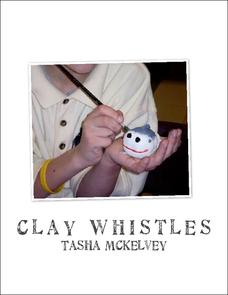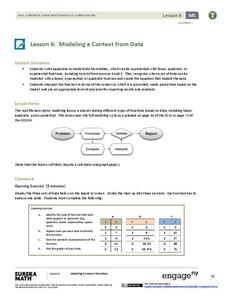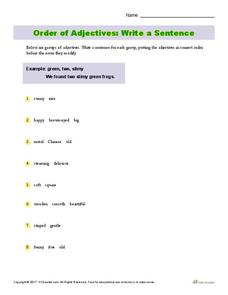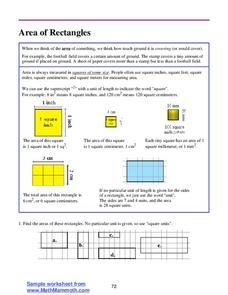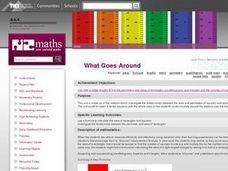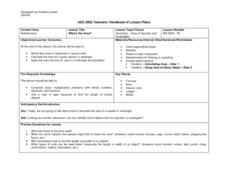Tasha McKelvey
Clay Whistles
Create clay whistles with your elementary or middle school young scholars. The project is outlined in great detail here, complete with step-by-step photographs, finished examples, a materials list, student handouts, and a rubric....
Common Core Sheets
Determining Coordinates: All Positive Coordinates
Take the numbers out of graphing with an activity about finding positive coordinates. Kids find each symbol or letter at various places on the grid, then note their coordinates in the space provided.
National Park Service
Living & Non-Living Interactions
What better way to learn about ecosystems than by getting outside and observing them first hand? Accompanying a field trip to a local park or outdoor space, this series of collaborative activities engages children in learning about the...
Math Sphere
Co-Ordinates
Challenge young mathematicians' understanding of the coordinate plane with this series of skills practice worksheets. Offering 10 different exercises that involve identifying ordered pairs, graphing polygons, and rotating/reflecting...
Ohio National Guard
Emotional Intelligence
Provide teenagers with the social skills they need to live happy lives with this collection of worksheets and activities. Covering a variety of topics from self-awareness and assertiveness, to stress management and problem solving, this...
Virginia Department of Education
Integers: Addition and Subtraction
Young mathematicians construct their own understanding of integers with an inquiry-based math lesson. Using colored chips to represent positive and negative numbers, children model a series of addition and subtraction problems as they...
K12 Reader
Point of View: Who Is Telling the Story?
See how famous books of literature have different perspectives with a short worksheet. After reviewing the difference between first and third person points of view, learners look over six passages from various novels and decide which...
DC Vote
One Kid, One Vote
Learn about why the citizens of Washington, D.C. feel unrepresented in Congress with an article about D.C voting rights. Individuals read about the movement toward congressional representation in Washington, D.C., before answering...
West Contra Costa Unified School District
Introduction to Inverse Functions
Ready to share the beauty of the inverse function with your classes? This algebra II activity guides the discovery of an inverse function through a numerical, graphical, and an algebraic approach. Connections are made between the three,...
Novelinks
Tuck Everlasting: Discussion Web Strategy
Guide learners through a discussion about Natalie Babbitt's Tuck Everlasting with a helpful graphic organizer. As they read through the novel, individuals note their reactions to statements about the book's themes, and fill out a chart...
EngageNY
Modeling a Context from Data (part 1)
While creating models from data, pupils make decisions about precision. Exercises are provided that require linear, quadratic, or exponential models based upon the desired precision.
Noyce Foundation
Rabbit Costumes
How many rabbit costumes can be made? This is the focus question of an activity that requires scholars to use multiplication and division of fractions to solve a real-world problem. They determine the amount of fabric necessary for eight...
University of Colorado
Strange New Planet
The first remote sensors were people in hot air balloons taking photographs of Earth to make maps. Expose middle school learners to space exploration with the use of remote sensing. Groups explore and make observations of a new planet by...
K12 Reader
Order of Adjectives: Write a Sentence
Knowing the parts of speech can make you a better writer! Young grammarians use sets of two and three adjectives to write engaging sentences, taking care to use the adjectives in the correct order.
American Statistical Association
EllipSeeIt: Visualizing Strength and Direction of Correlation
Seeing is believing. Given several bivariate data sets, learners make scatter plots using the online SeeIt program to visualize the correlation. To get a more complete picture of the topic, they research their own data set and perform an...
American Museum of Natural History
What Do You Know About Astronomy
Develop an understanding of the universe. Learners answer 10 multiple choice questions about several topics in astronomy. Questions contain information about the age of the universe, gravitational attraction, galaxies, planets and comets...
Curated OER
Area of Rectangles
In this rectangle worksheet, students find the areas of rectangles and draw squares to a given size, Examples and explanations are provided prior to the exercises. There are eight problems provided on this two-page worksheet.
Curated OER
Investigate Perimeter
In this perimeter instructional activity, students are given perimeter and draw 3 different squares or rectangles on given grids, using those given measurements, then complete 2 related questions.
Curated OER
Area
For this area worksheet, students use square models or grid paper, estimate, then find the area of given shapes. Houghton Mifflin text is referenced.
Curated OER
Finding Areas of Plane Figures
Students compute areas of squares, rectangles, and so on and summarize the formulas for computing areas and explain how the formulas are derived and understand the reasoning behind them.
Curated OER
Finding Perimeter and Area
Third graders understand the perimeter by units and now find perimeter by addition. In this perimeter lesson plan, 3rd graders relate their prior knowledge to adding the sides of the perimeter by answering a series of questions.
Curated OER
Finding Area
Fourth graders explore how to find the area of a rectangular object. As a class, they discuss definition of area and strategies for finding area. The teacher models finding the area of an object by counting squares. Students observe...
Curated OER
What Goes Around
Fourth graders investigate the relationships between the area and perimeters of squares and rectangles. They calculate the perimeter of rectangles and squares using a formula. Students investigate the relationship between the perimeter...
Curated OER
What's the Area?
Fifth graders use area to calculate the cost for new flooring. They find the area of a square or rectangle. Calculating Area problems and worksheet are attached.
Other popular searches
- Finding Area in Square Units
- Area Square Units
- Math Area Square Units
- Area in Square Units
- Count the Square Units
- Area of Square Units
- Area and Square Units
- Changing Square Units
- Square Units Worksheet
- Square Units Blocks
- Math Square Units
- Perimeter in Square Units


